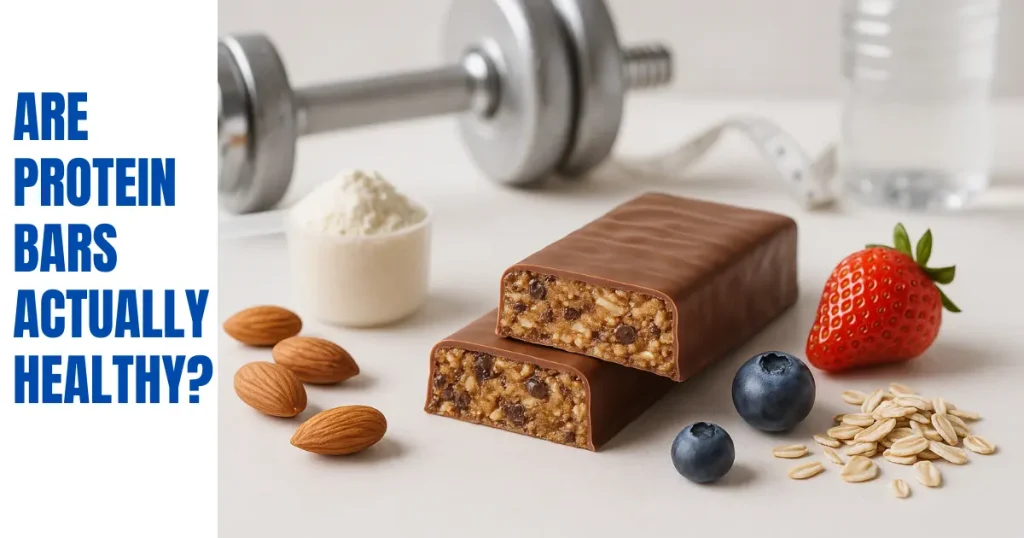
Introduction
Protein bars are everywhere—from gyms and office drawers to supermarket shelves and vending machines. Marketed as a convenient, high-protein snack, they claim to boost energy, support muscle growth, and help with weight loss.
But is a protein bar really healthy or just a glorified candy bar dressed in fitness marketing?
In this SEO-optimized, fully updated, 1500-word article backed by EEAT (Expertise, Experience, Authoritativeness, and Trustworthiness), we’ll dissect what’s inside a protein bar, compare different types, highlight who should eat them—and who shouldn’t.
What Exactly Is a Protein Bar?
A protein bar is a compact, shelf-stable snack designed to deliver a high amount of protein (usually between 10g–30g per bar), along with varying amounts of carbohydrates, fats, and fiber.
They’re often used:
- Post-workout for muscle recovery
- As a meal replacement on-the-go
- To curb hunger between meals
- In weight loss plans for calorie control
But not all protein bars are created equal—some are as nutritious as a homemade chicken salad, while others rival a candy bar in sugar and preservatives.
Typical Ingredients in Protein Bars
Protein bars can contain dozens of ingredients. Here’s what you’re usually eating:
✅ Common Healthy Ingredients
- Whey, casein, or plant-based protein (pea, rice, soy)
- Nuts and seeds (almonds, chia, flax)
- Oats or whole grains
- Natural sweeteners (honey, dates, stevia)
- Fiber (chicory root, inulin)
❌ Ingredients to Watch Out For
- High fructose corn syrup
- Artificial sweeteners (sucralose, aspartame)
- Hydrogenated oils or trans fats
- Excessive saturated fat
- Sugar alcohols (erythritol, maltitol – may cause digestive issues)
- Gums and thickeners (xanthan gum, carrageenan)
- Preservatives and synthetic additives
Nutrition Profile: What Makes a Healthy Protein Bar?
A truly healthy protein bar should have:
| Nutrient | Ideal Range |
|---|---|
| Calories | 150–250 (snack) / 300+ (meal) |
| Protein | 10–20g (at least 15g for muscle support) |
| Sugar | Under 8g (ideally from natural sources) |
| Fiber | 3–10g (supports satiety and digestion) |
| Fat | 5–12g (from healthy sources like nuts) |
| Carbs | 15–25g (depending on activity level) |
Top Health Benefits of Protein Bars
1. Convenient Source of High-Quality Protein
A good protein bar gives you complete protein (with all essential amino acids), crucial for:
- Muscle repair and growth
- Hormone production
- Metabolic health
Especially helpful for:
- Busy professionals
- Athletes or gym-goers
- Vegetarians struggling to meet daily intake
2. Satiety and Appetite Control
Thanks to protein + fiber, quality bars help you feel full, reducing cravings and mindless snacking.
Research shows high-protein snacks lead to:
- Reduced ghrelin (hunger hormone)
- Lower calorie intake at later meals
3. Weight Management
When used properly, protein bars can:
- Prevent overeating
- Replace unhealthy snacks
- Help meet macro targets on weight-loss diets
Many bars are portion-controlled and lower in calories than fast food, making them a helpful tool—not a magic bullet.
4. Supports Blood Sugar Balance
Protein slows down the absorption of sugar into the bloodstream, minimizing spikes and crashes.
Some bars even include low-glycemic carbs, making them diabetic-friendly (always check labels and consult a doctor).
5. Travel and Emergency-Friendly
No fridge? No time? No problem. Protein bars are:
- Shelf-stable for months
- TSA-approved
- Ideal for hiking, travel, or emergency kits
When Is a Protein Bar Unhealthy?
Despite the benefits, not every bar is a smart choice. Here’s when they can do more harm than good:
❌ 1. Loaded With Sugar
Many bars contain:
- 10–20g of added sugar
- Syrups, cane sugar, or even sugar alcohols that upset your gut
This can lead to:
- Blood sugar spikes
- Increased fat storage
- Insulin resistance over time
❌ 2. Ultra-Processed Ingredients
Some bars have over 20–30 artificial ingredients, including:
- Flavor enhancers
- Preservatives
- Synthetic fibers
This lowers nutrient quality and may cause digestive discomfort or food sensitivity.
❌ 3. Poor Protein Sources
Watch for:
- Collagen-only protein (incomplete amino acid profile)
- Low protein (<10g) with lots of sugar/fat (aka a candy bar in disguise)
Always check the label for whey, casein, egg, or quality plant proteins.
❌ 4. High Calorie Bombs
Some bars marketed as “healthy” contain:
- 400+ calories
- High saturated fat
- Low fiber
These are more like desserts or meal replacements, not light snacks.
Comparing Protein Bars to Whole Foods
| Metric | Protein Bar (average) | Whole Food Snack (e.g. boiled eggs + fruit) |
|---|---|---|
| Protein | 10–20g | 12–15g |
| Sugar | 6–15g (added) | 0–5g (natural) |
| Satiety | Moderate | Higher (due to bulk & water content) |
| Digestibility | May cause bloating | Easier to digest (fewer additives) |
| Nutrient density | Variable | Generally higher in vitamins/minerals |
Verdict: Protein bars are convenient, but can’t fully replace whole, nutrient-rich snacks. Use them to supplement, not substitute, real food.
Who Should Eat Protein Bars?
✅ Ideal For:
- Athletes needing quick post-workout protein
- Busy professionals who skip meals
- Travelers who lack access to fresh food
- Vegans/vegetarians seeking extra protein
❌ Not Ideal For:
- People with sensitive digestion (due to sugar alcohols or fiber additives)
- Children (many contain caffeine, high protein not needed)
- Individuals with kidney issues (consult doctor before increasing protein)
How to Choose a Healthy Protein Bar
🛒 Smart Checklist:
- ✅ 15–20g of protein
- ✅ Under 8g of sugar
- ✅ At least 3g fiber
- ✅ No artificial sweeteners or hydrogenated oils
- ✅ Protein from whey, casein, egg, or complete plant sources
- ✅ <250 calories (unless meal replacement)
Best Protein Bars (2025 Review)
| Brand | Protein | Sugar | Calories | Notes |
|---|---|---|---|---|
| RXBAR | 12g | 0–5g | 200–220 | Made with whole food ingredients |
| Quest | 20–21g | <1g | 190–210 | Low-carb, high fiber |
| Kind Protein | 12g | 7g | 250 | Made with real nuts, natural sugar |
| Clif Builder | 20g | 17g | 270 | Great for post-workout, high sugar |
| No Cow | 20–22g | 1g | 200–210 | Dairy-free, good for vegans |
✅ Always read the ingredient list—cleaner is better.
Protein Bars and Weight Loss: Do They Help?
Yes—but only when:
- They replace unhealthy snacks
- You use them to meet protein targets
- You stay within your calorie range
🚫 They don’t help if you:
- Eat multiple bars daily
- Choose high-calorie, high-sugar versions
- Treat them as “free foods”
Can You Eat a Protein Bar Every Day?
Yes—if:
- It fits your macros and goals
- You choose a clean, high-quality bar
- You balance it with whole foods and variety
Avoid becoming dependent on them as your primary food source.
Final Verdict: Is a Protein Bar Really Healthy?
Yes — but only if you choose the right one.
Protein bars can be a healthy, practical snack, but their value depends on:
- The ingredients
- The brand
- Your goals and dietary needs
✅ Choose bars that are:
- High in complete protein
- Low in added sugars
- Free from junk fillers
🚫 Avoid bars that are:
- Candy bars in disguise
- Filled with artificial junk
- Used as full meal replacements too often
FAQs
1. Are protein bars good for weight loss?
Yes, if they help you control hunger and reduce calorie intake—just avoid high-calorie versions.
2. Can I eat protein bars without working out?
Yes, but choose lower-calorie versions if you’re sedentary.
3. Are protein bars safe for kids?
Generally not recommended unless they’re designed for children—too much protein, artificial sweeteners, and caffeine in some.
4. Are plant-based protein bars healthy?
Yes—if they use complete plant proteins (like pea + rice combo) and clean ingredients.
5. What’s the best time to eat a protein bar?
Post-workout, mid-morning, or afternoon—when you need energy or muscle support.
Final Tip:
Treat protein bars as a convenient supplement, not a daily crutch. Whole foods come first—protein bars are second-best when life gets hectic.



